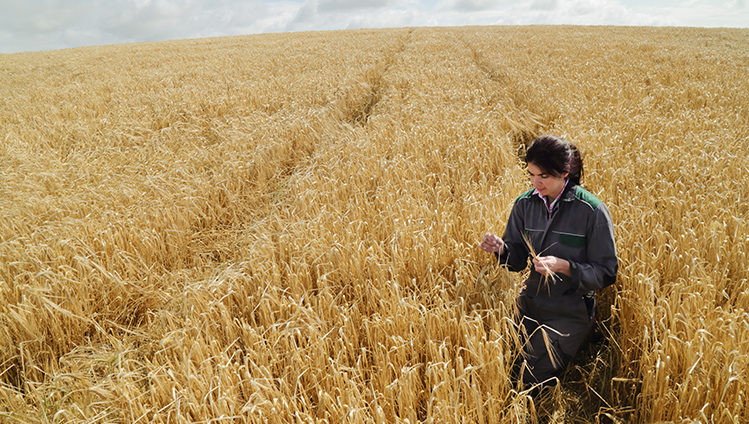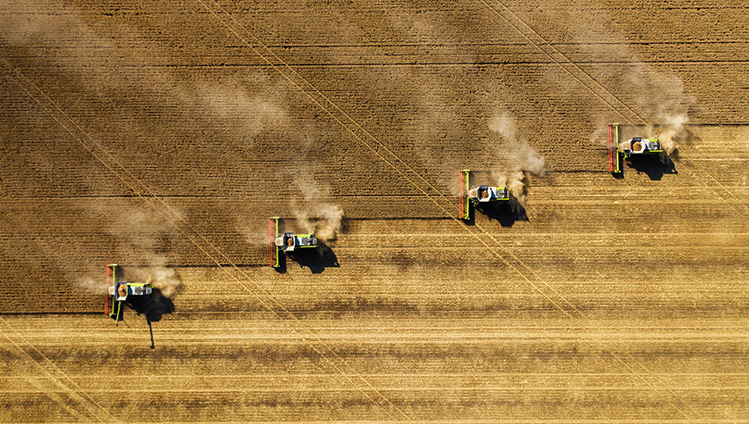Agriculture plays a major role for our lives, especially in populous countries. In Germany alone, almost half of the total land area is used for agriculture. The importance of agriculture for the future of life on our planet can hardly be overestimated. More than any other sector, it is at the crossroads of three global challenges.
Megatrends challenging the agricultural sector

First, the global population is continuously growing. By 2050, the United Nations expects the world to be home to 9.8 billion people – around 2.2 billion more than today. Feeding these people is in itself a daunting task for agriculture. It will be exacerbated by the fight against another global trend: climate change. The agricultural sector is both a contributor and a victim of this issue.
Climate change is endangering farmland and water resources through heat, drought, and weather extremes – with sometimes devastating consequences. It is estimated, for example, that global wheat production is likely to fall by an average of six percent for every additional increase in global temperature of one degree Celsius. At the same time, the steady increase in a world population that needs to be fed is increasing the pressure on climate and biodiversity.
According to the Intergovernmental Science-Policy Platform on Biodiversity and Ecosystem Services (IPBES), around one million species are currently threatened with extinction. To slow down or even stop this development, we need new types of digital solutions applied in the field, for example to apply crop protection products only where they are really needed. It will be about combining the best tools from seeds, traits, digital services, and crop protection.
Digitization delivers various solutions
None of these mega trends – population growth, climate change and the threat to biodiversity – can be considered apart from the others as they are each mutually dependent. The answer to these mega trends is based in part on digitization. Innovative solutions use artificial intelligence, new technologies, and smart ideas. How this might look became visible once again at the Consumer Electronics Show (CES) in Las Vegas, where manufacturer John Deere presented an autonomously driving tractor that plows fields and relieves farmers.
This is just one example of where we are headed in the coming decades. What we need is a mix of solutions aimed at increasing productivity without increasing the amount of land under cultivation. And, at the same time, we have to better protect the climate and our environment.
After all, if agricultural productivity were to remain constant at today’s levels until 2050, the world’s population could only be fed if most of the forests were cleared. The result would be the extinction of thousands of animal species and the release of greenhouse gas emissions at a rate that would exceed the Paris Agreement’s 1.5- or 2-degree target – even if all other man-made emissions were eliminated.
Smart farming – the future of agriculture
All these forecasts and trends lead to several urgent questions: How can we produce more efficiently? How can we improve time-to-market and product performance? How can we increase sustainability and serviceability? What can we do to raise the quality of our food? And how can we better protect the planet through our agriculture in the future? One of the most important answers to these questions is a digitalized agriculture – also called smart farming.
This answer requires intelligent technologies of the future, for example concepts for robots that could work autonomously in the field and, with the appropriate attachments, monitor plant growth and weeds or apply seed and fertilizer in a targeted manner. Based on cameras, multispectral or thermographic sensors, radar and lidar systems, modern software can provide the data needed.
As machines have become heavier over the last decades, soil compaction is another relevant topic. The solution could be reflected by small and light robots that could work autonomously on the fields, for example by doing the sowing or cutting weeds. These robots might also use different attachments, monitor crop growth, pull up weeds, and distribute seeds and fertilizer when and where they are needed. These tasks would require the use of camera-based, multispectral, or thermographic sensors.
Versatile drones, customized instruments, and durable belts
Innovative drone technology also offers great potential in the coming years. Supported by GPS data, these autonomous flying all-around devices can, for example, distribute pesticides efficiently and quickly in the field or protect fawns before mowing. Trials with drones are already underway in viticulture as well. As vintners are increasingly struggling with heat and drought, drones could use special cameras to record a thermal image and thus quickly and precisely determine the water balance in the vineyard.

Besides this, a new generation of body electronics for tractors and other agricultural vehicle types will play an important role for farmers. These displays and instruments are extremely resistant and installed in the vehicle’s cockpit. Customized instrument clusters can be tailored to the personal requirements and used in every commercial vehicle.
On the way to more efficient agriculture, the reliability of the equipment used will also play a key role. While extreme weather conditions present the sector with ever new challenges, durable agricultural belts, for example, will enable consistent production and help to minimize downtime to ensure that harvesting can be completed on time, every time.
Sensor technology will support this by enabling the continuous monitoring of drive belts in combine harvesters to detect impending malfunctions before they occur. Thus, unscheduled and costly machine downtime will be avoided. Finally, increased reliability will save time, money, and materials – and allow service partners and manufacturers to improve their response time, availability, and service quality.
Understanding change as a chance
For all these areas, Continental is currently developing or already offering smart and intelligent solutions. While customers are mainly focusing on supply chain aspects, such as production capacities, specific expertise, safety, and efficiency, megatrends will have an increasing impact on agriculture in the future. The entire automotive sector will tackle many challenges and thus be forced to create new ideas and products.
Thanks to another trend, digitalization, there are many opportunities to realize this transformation. But, while agricultural equipment industries will pave the way to sustainable, efficient, automated, and smart farms, there’s only one way to understand this change – as a chance.







